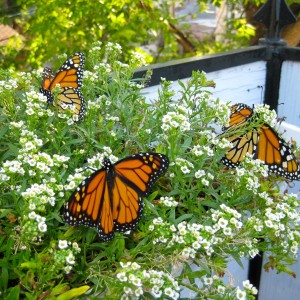Everyone knows that honey bees are very important pollinators. They travel from flower to flower, gathering nectar and pollen for their very survival. In the process, they’re also transferring the pollen grains that are essential to further seed and fruit production from one plant to another. Honey bees play an extremely important role because the act of pollination provides us with nearly half of the foods we consume, making pollination an essential part of our overall food system.
But honey bees aren’t the only insects that play a part in pollination. Hummingbirds, bats, beetles, moths and yes, even butterflies also play a part in helping to pollinate our world.
 Pollination is Important
Pollination is Important
Worldwide, there are more than 1350 different types of plants that provide us access to certain foods, drinks, medicines and more. Of this number, nearly 1000 rely on pollination. Examples of foods we consume that rely on pollination include apples, berries, tomatoes, beans, grains, peppers, cherries, avocados and coffee (there’s much more!). Pollination is also critical to the smooth running of our ecosystems.
So although we rely on the honeybee for the majority of our pollination needs, butterflies are also great pollinators, too.
Butterflies Pollinate, Too!
Because butterflies fly from one flower to the next looking for the nectar they drink as food, they’re pollinators, too! When butterfly’s land on a flower to look for nectar, some pollen will stick to their legs and parts of their body. This pollen is now transferred to the next few flowers that the butterfly lands on. Because of their shape, bees are a little bit more efficient at spreading the pollen because it tends to stick to their entire body when they land on a flower.
Although butterflies aren’t able to transfer as much pollen from one plant to another as bees do, butterflies do tend to fly longer distances than bees so they’re able to spread the pollen around a larger area.
How You Can Help
The following are a few things you can do to create a pollinator-friendly atmosphere at your home.
• Plant a butterfly-friendly flower garden
• Plant a vegetable garden
• Use native plants – inside and outside your home
• Create water areas
• Practice organic methods – try not to use chemicals




Off